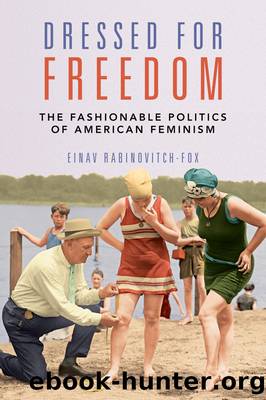Dressed for Freedom by Einav Rabinovitch-Fox

Author:Einav Rabinovitch-Fox [Rabinovitch-Fox, Einav]
Language: eng
Format: epub
Tags: Social Science, General, Women's Studies, History, Women, Feminism & Feminist Theory
ISBN: 9780252052941
Google: iadGEAAAQBAJ
Publisher: University of Illinois Press
Published: 2021-11-16T04:26:52+00:00
FIGURE 4.1: Department stores, particularly Lord & Taylor under the management of Dorothy Shaver, were instrumental in promoting female American designers in the interwar period, marketing their clothes as designed by and for the modern American woman. (Fashions of Lord & Taylor, window display featuring American designers, 1933 Worsinger photo, X2010.11.4555, Museum of the City of New York)
Whereas the segregation of the printed media meant that most of the attention in the popular press was directed toward White designers, the Black press celebrated the achievements of African American designers, covering them and their fashion shows extensively. The Black press also provided a platform for designers to advertise their business, further advancing their public visibility.54 NAFAD in particular played an important role in increasing designersâ name recognition among the Black community. NAFAD members used their connections with Black publishers to publicize the organizationâs fashion shows and membersâ designs, giving attention not only to the clothes but also to the women who made them. Articles about NAFAD and its activities often included photographs of models wearing African American designs, with credit to the designers. Some articles also included photographs of âdesigners at workââwhich, as in the White press, raised their celebrity status.55
Although career women, and fashion designers in particular, were only a minority among working women, they represented a subtle shift in ideas of femininity in the interwar period. Indeed, the female designer became the ultimate role model and a consumer of a style that fitted the âbright, resourceful, daring, and unprejudiced young woman,â incorporating a strong and independent mind with feminine beauty.56 The association of high fashion with femininity that designers embodied through their image and work turned the career woman from a threat into a positive and fashionable figure. Yet, in presenting the female designer as a desirable role model for the average consumer, magazines did not just popularize fashion design as a career for women, they popularized careers in general. Paid labor was recognized not only as a temporary stage in womenâs life or as a marker of working-class status but as a respectable path for the middle-class woman. In a 1934 Vogue spread titled âBeauty and Four Women,â the âBusiness Womanâ and the woman on a âLimited Incomeâ joined the âLeisured Ladyâ and the âGlobe-Trotterâ as archetypes of beauty, modernity, and progress.57 No longer a curiosity, the pursuit of a business career became a legitimate, even desired, aspect of womanhood for both Whites and Blacks.
Magazines appealed directly to the young working woman, giving her advice on how to pick the right colleges, to apply for a job, to handle office etiquette, and of course, how to maintain a suitable wardrobe.58 In 1936, for example, the Pictorial Review published a spread titled the âThe Busy Womanâs Wardrobe Does 24 Hours Duty,â giving women sartorial solutions for working, shopping, and meeting friends.59 Department stores also began featuring suitable work attire in their windows, quite literally selling the notion of career-oriented femininity as a desirable aspect.60 By 1941, new magazines appeared
Download
This site does not store any files on its server. We only index and link to content provided by other sites. Please contact the content providers to delete copyright contents if any and email us, we'll remove relevant links or contents immediately.
| Designers | Fashion Photography |
| History | Models |
Tokyo Geek's Guide: Manga, Anime, Gaming, Cosplay, Toys, Idols & More - The Ultimate Guide to Japan's Otaku Culture by Simone Gianni(2314)
Batik by Rudolf Smend(2123)
Life of Elizabeth I by Alison Weir(2023)
The Little Book of Bettie by Tori Rodriguez & Dita von Teese(1623)
Vogue on: Dolce & Gabbana by Luke Leitch(1590)
Vogue on: Manolo Blahnik by Chloe Fox(1515)
Paris Undressed by Kathryn Kemp-Griffin(1452)
A Victorian Lady's Guide to Fashion and Beauty by Mimi Matthews(1368)
How to Dress by Alexandra Fullerton(1340)
Pretty Iconic by Sali Hughes(1317)
Indigo by Catherine E. McKinley(1261)
The Light of the World by Elizabeth Alexander(1214)
101 Things I Learned in Law School by Matthew Frederick(1174)
The Language of Fashion by Barthes Roland(1162)
Lazy Perfection by Jenny Patinkin(1148)
Fashion Victims by Alison Matthews David(1147)
Fashion Illustration 1920-1950 by Walter T. Foster(1134)
House of Versace: The Untold Story of Genius, Murder, and Survival by Ball Deborah(1122)
Face Paint: The Story of Makeup by Lisa Eldridge(1102)
